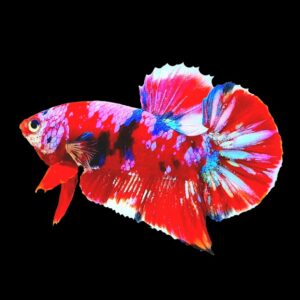In certain circles, when you mention butterfly koi it’s like speaking out of turn in an audience with the president. You just don’t do this. Quite a few koi connoisseurs, who demand high quality koi fish, think of butterfly koi as “mutts,” and some say that butterfly koi aren’t even koi. Others, however, happen to think butterfly koi can be the finest koi in any collection, depending on several factors – size, pattern, and finnage.
Butterfly koi stir strong opinions because they diverge from the strict traditional standards of koi classification. However, their elegance, uniqueness, and flowing fins have earned them admiration across a new generation of collectors and pond enthusiasts. These fish reflect how koi culture continues to evolve beyond rigid guidelines, embracing beauty in new forms.
Where Did They Come From?
In the early 80s, a population of common, brown and grey carp with long fins were found in a series of canals and ditches in Indonesia. A company in New York took an interest and brought the fish into the U.S. and sold some. They did not sell well because they were ugly. However, an enterprising and curious group of breeders placed an order for a dozen of these fish to see what the heck they were. Ugly, with long fins, is what they discovered. Over the next several years they bred these large, long finned mutations with their finest regular-fin koi and made several discoveries.
The origins of butterfly koi are a tale of experimentation and observation. These long-finned fish, initially dismissed as unattractive oddities, would eventually transform into a celebrated variety of ornamental pond fish. With time, intentional breeding brought out their best traits—color, endurance, and stunning finnage.
- Long-fin genes are dominant, so breeding the fish back to color would not breed out the long fin gene.
- Long-fin koi are robust and disease resistant.
- The fish could be bred back to color and many colorful lines of long-fin koi have been created.
The Relation of Size and Value
As butterfly koi grow, they become more and more impressive because the fins keep growing until the blood vessels can’t sustain the fins to be any longer. The older the fish, the longer and more impressive the finnage. So, a full-grown butterfly koi looks like a long, slinky dragon moving through the water. Their barbels (whiskers) even grow long and can fork into elaborate designs.
While butterfly koi may not bulk up like standard koi, their elongated shape and lengthy fins create a more fluid silhouette. Their movement through water is mesmerizing, and they draw attention for their graceful swimming style, often looking ethereal compared to the blockier shapes of traditional koi.
What About Pattern?

Since pattern seems to mean a great deal to the value of a regular koi, it makes logical sense that a good, standard pattern with bright colors would increase the value of a butterfly koi too, but there are a few notable additions. While a butterfly koi is more valuable when it has a properly defined and positioned pattern in the color, beautiful fins can often make even a poorly patterned fish look beautiful.
With butterfly koi, the interplay of pattern and fin elegance is what sets them apart. A well-positioned splash of color on a luminous body, accompanied by flowing fins, creates a visual spectacle. This combination makes them favorites among collectors looking for both color brilliance and motion.
In addition, lemon and platinum ogons (solid color) in the butterfly category are awesome as adults. When you grow a metallic yellow or platinum ogon butterfly to an impressive, large size, their body movement is more graceful and slow. The fins are long, but the uniform gold or neon-white color is brilliant in the water and such fish look like fireballs or comets moving through the water with their “fire” (fins) streaming behind them. Gorgeous!
Notable Butterfly Koi Types
Sorogoi are incredible as adults in the butterfly class, as well. A sorogoi is the overall grey fish with the “fukurin” or black fish net pattern over the body. So, taking that color and putting it on a large, impressive adult butterfly koi gives you what rather appears as a grey sea monster moving through the water. Its subdued colors don’t attract the eye at first, but then you see its graceful, lengthy body and fins moving around below you and you are taken aback by both the robustness of the fish (they grow huge) and its mysterious, grey color.
Each type of butterfly koi carries its own unique visual appeal. Whether it’s the shimmer of a metallic fish or the mysterious allure of a net-patterned sorogoi, their diversity offers something for every taste. Their growing popularity is a testament to how varied appearances can enhance a pond’s aesthetic.
Even better than that are black butterflies – which are, by far the coolest fish. They are seldom found, so the effect is rare and special when it happens. The black butterfly may be with or without scales. The rarest and most valuable of this type is the doitsu, karasu butterfly. This fish is black, has no scales, and has long fins.
Black Beauties
Black butterflies grow up and become very large because their genes are not as strained as some of the brighter colored fish. And if they have no scales, the body is a glistening jet-black. The fins keep growing until the entire fish is broad, and streams long black robes behind it. They look like a jet-black dragon.
These fish are often the most dramatic residents of a pond. Their shadow-like appearance and quiet approach give them a mystique that captivates viewers. For those seeking a centerpiece fish that inspires awe, the fully mature black butterfly koi is a showstopper.
And when a visitor to your pond is feeding your fish at the side of the pond, suddenly, a large black shadow looms up from the depths. Larger it gets, until they realize that there is no color, the fish is just a shadow and when the fish takes the food, it turns and swirls down out of sight with a flourish of long, black fins. “What was that?” they usually stammer. “That is the shadow. He’s our black fish, which the Japanese have always regarded as a lucky fish,” you reply. The fully mature black butterfly koi is surely one of the most memorable fish a kid could ever encounter or feed. With such a fish, you own a living breathing shadow dragon.
Oh Those Fins!
In a discussion of butterfly koi, we should talk a tiny bit more about the fins. The butterfly koi fins are long because of a genetic aberration resulting in the length growth gene failing to turn off. In fish, the fins are supposed to grow to a genetically specified length, and then stop growing. But in the high fin mutation the fins don’t get the “stop growth” message and they keep growing. This happens in individual fish of many species from time to time. Some notable examples are Siamese fighting fish, Simpson’s hi fin swordtails, long fin oscars, and long fin black tetras. Any time the mutation is encountered and identified, it is bred into a species to see if it would make that species more economically important commercially.
This extended fin growth doesn’t just create beauty—it also reflects the resilience of the fish’s genetic makeup. The mutation has shown stability and desirability, which is why breeders across species seek it out. Long fins become a signature feature that transforms ordinary fish into aquatic art.
Like any other koi, the fins of the butterfly koi are made up of dozens of rays of cartilage that radiate outward and support the fin. These rays generally grow very straight, but past the point of normal length they can grow wavy. The fish that grow straight rays even into the lengthier parts of the tail are more impressive looking and would be more valuable.
One problem with butterfly koi is that they are often handled the same way as regular koi. Broken fins and tails are par for the course by the time the fish is an adult. So, it’s normal to see bends and waves in the fins and tail of butterfly koi partly because of growing that way, but also because of netting-damage as a juvenile. As an adult, a split tail or fin often does not heal well and remains split. All of the above is irrelevant to the casual observer, the impact of the fish is exactly the same, but you might notice variations in fin quality and you may care enough to choose one fish over the other based on that.
Are They the Real McKoi?
The butterfly koi is a true koi. Despite this fact, some traditionalists have shared distaste for these long fin beauties. Truth be told, new varieties and colorations are often met with skepticism before eventually becoming accepted—and even beloved—parts of koi culture.
What began as resistance has turned into growing appreciation, as collectors recognize the elegance and diversity that butterfly koi bring to the pond. Over time, these fish have become celebrated for how they expand what koi can be, proving that innovation has its place even in centuries-old traditions.
At first, only one breeder in Japan produced butterfly koi, and the fish were gorgeous, often bred for prodigious size. But most others declined. That breeder’s fish became so popular abroad that they became scarce; encouraging others to follow suit. Today, many domestic breeders produce butterfly koi. They are very popular fish – and for good reason.


